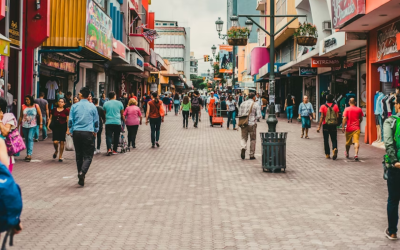The Day of the Black Person and Afro-Costa Rican Culture, observed annually on August 31st, showcases the vibrant African essence of Costa Rica’s Caribbean Coast, Limón, which in the past was an area filled with banana plantations.
The land vibrates with its people’s rhythm, vigor, and pride in its roots. During the procession, afro-Caribbean music, vivid costumes, jewelry, hairstyles, and headdresses transport spectators to Africa and the Antilles. These traditions connect Limón’s afro Caribbean community to their ancestors and preserve their history.

What’s the History Behind the Day of the Black Person and Afro-Costa Rican Culture?
Black Peoples Day (Dia del Negro) was officially declared by Costa Rica on August 31st in the 1980s, and the holiday’s scope was later broadened to include Afro-Costa Rican culture with the proclamation of Dia del Negro y la Cultura Afrocostarricense. This initiative was promoted by the Union of Costa Rican Educators (SEC) during the administration of Rodrigo Carazo.
This date commemorates the First International Convention on Blacks, which finished at Madison Square Garden in New York on August 31, 1920. That convention produces “The Declaration on the Rights of Blacks.”
In 1999, Limonenses worried about the loss of black culture’s values and traditions, saw the need to form the Black Ethnic Cultural Civic Committee.
What Percentage of Costa Ricans are Black?
Costa Rica currently has an 8% Afro-descendant population, and nearly 24 percent (roughly 90,000 people) make up the Afro-Caribbean community of Limon. Most of them are descendants of Jamaican workers who arrived in the country looking for job opportunities.
It is considered that 32% are in the central valley, and the rest are divided throughout the Costa Rican territory. A portion of the people of the province of Guanacaste are Afro-Mestizo, meaning that they are descended from a mixture of local Amerindians, Africans, and Spaniards.
Where Can I Find Afro-Caribbean Culture in Costa Rica?
- Music: It reflects the history and experiences of the Afro-Caribbean community in Costa Rica. It includes genres like calypso, socca, and reggae. Walter Ferguson, the “King of Calypso” in Costa Rica, and Gilberth “Saba” Córdoba, a percussionist and bandleader, are famous Afro-Caribbean artists from Costa Rica.
- Dance: The Carnaval de Limón features live music and dance performances with colorful costumes and parades. It is one of the biggest celebrations for Afro-Costa Ricans.
- Cuisine: In Limon, especially in tourist places like Cahuita or Puerto Viejo, you can find the finest selection of Afro-Costa Rican cuisine. Taste dishes such as rice and beans, coconut bread, and seafood soup to satisfy your delicate taste buds.
- Language and expressions: Also known as Limonese Creole English, Patois is a unique language that combines English, Spanish, and African dialects. It is primarily spoken in Limón Province. You’ll hear locals speaking this attractive tongue while visiting this paradise.
- Art and literature: Visit the Museo Etnohistórico de Limón to learn about the history and culture of the Afro-Caribbean people in Costa Rica, including their art and literature. You can also visit Casa de la Cultura, which hosts art exhibitions and literary events that showcase the work of Afro-Caribbean artists and writers.

How Do Costa Ricans Celebrate the Day of the Black Person and Afro-Costa Rican Culture?
August 31st is now an official national holiday. During this day, a parade fills the city with lively crowds and vibrant floats, moving in harmony with the sounds of bands and drums. Limón’s streets are filled with people celebrating with love, friendliness, respect, and creativity.
Some Afro-Costa Rican communities organize gatherings and events to celebrate their cultural heritage. These events may include family reunions, church services, or community dinners.
Costa Rican museums, galleries, and cultural centers exhibit Afro-Costa Rican history and culture. These exhibitions generally showcase Afro-Costa Rican contributions and experiences through art, antiques, and pictures.
Afro-Costa Rican Culture Beyond the Day of the Black Person
Events, cultural activities, and museums dedicated to preserving and promoting the history and cultural heritage of the Afro-Costa Rican people are held throughout the year, not just on the Day of the Black Person, to commemorate and acknowledge Afro-Costa Rican culture.
Year-round events and cultural activities
Afro-Costa Rican artists have significantly contributed to Costa Rican culture, and several art exhibitions throughout the country showcase their work. Additionally, it is possible to find different cultural activities that include music, food, and dances from the Atlantic coast.
Museums and cultural centers dedicated to Afro-Costa Rican history
The main museum dedicated to Afro-Costa Rican culture is the Museo Etnohistórico de Limón. Plus, other museums feature exhibits and artifacts that showcase the history and culture of the Afro-Costa Rican community, like the Museo Juan Santamaría in Alajuela and the Museo de Arte Costarricense in San Jose.
The Afro-Costa Rican culture is a vibrant and unique aspect of the country’s rich cultural heritage. If you want to experience the Afro-Costa Rican culture firsthand, we invite you to book a tour with Find My Costa Rica. Our expert tour guides are passionate about sharing the beauty and richness of Costa Rica’s culture with travelers from all over the world.
Get ready for a once-in-a-lifetime cultural experience and book a tour with Find My Costa Rica today!



